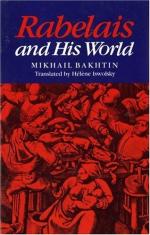
|
| Name: _________________________ | Period: ___________________ |
This test consists of 15 multiple choice questions and 5 short answer questions.
Multiple Choice Questions
1. Bakhtin asserts that Rabelais' grotesque conception of the body reflected:
(a) The Renaissance re-envisioning of the cosmos.
(b) The Classical philosophy of Epicureanism.
(c) The Calvinist idea of predestination and grace.
(d) The Medieval doctrine of natural hierarchy.
2. What does Bakhtin consider the "symposium" of Medieval grotesque realism?
(a) The tradition of festive speech.
(b) Refereed debates between two clergymen.
(c) Bear-baiting in the town square.
(d) Vows spoken between lovers.
3. What is revealed in images of "negation"?
(a) The destructive impulse of humanity.
(b) The opposition to the official world.
(c) The harmful aspects of society.
(d) The refusal of commitment between lovers.
4. According to Schneegans, what is the grotesque in art?
(a) A representation of an otherworldly object.
(b) A caricature that has reached exaggerated dimensions.
(c) A spoken-word performance involving violent acts.
(d) A portrait that has been defaced.
5. The defense of the abbey by Friar John contains:
(a) A travestied allusion to Communion.
(b) A grotesque combination of sexual intercourse and war.
(c) A debasing description of the French people.
(d) A caricature of the Pope.
6. Bakhtin asserts that "The Play in the Bower" influenced Rabelais' work specifically in its:
(a) Themes of human sadness, pessimism, and regret.
(b) Adherence to the rules of proper religious worship.
(c) Demonstration of rigid and correctly class-conscious behavior.
(d) Themes of unofficial laughter and banquet imagery.
7. How does Bakhtin define "folly" as it relates to festivity?
(a) Ambivalent.
(b) Artistic.
(c) Pessimistic.
(d) Inaccessible.
8. What are the three categories of the "comic" which Bakhtin cites from Schneegans?
(a) The clownish, the burlesque, and the grotesque.
(b) The satiric, the clownish, and the visual.
(c) The painted, the sketched, and the acted.
(d) The grotesque, the ridiculous, and the satiric.
9. Bakhtin asserts that man introduces the world to himself primarily through which act?
(a) Eating.
(b) Sexual intercourse.
(c) Observing nature.
(d) Conversation.
10. According to Bakhtin, Carnival was the true symbol and incarnation of:
(a) The power of the monarchy.
(b) The natural world.
(c) The sanctity of the Church.
(d) The folk festival.
11. How does Friar John interpret the riddle he and Gargantua hear?
(a) As a promise of winter floods and summer drought.
(b) As a representation of a tennis match.
(c) As a promise of Armageddon and the return of Christ.
(d) As an indication of his own increasing wealth.
12. In Rabelais' novel, the "ancestral body" to which Bakhtin refers means:
(a) The record of births and deaths kept by local churches.
(b) The features of one's body in which one resembles one's parents.
(c) The portions of the body that die over time, like hair and fingernails.
(d) The generative organs which produce children.
13. What is a Renaissance "diablerie"?
(a) A portion of Carnival in which actors dress up as devils.
(b) A type of behavior manual that purports to stop devilish behavior.
(c) A series of prayers one says to beg forgiveness for misbehavior.
(d) A curse one shouts at another, meaning, "To the devil with you!"
14. Bakhtin finds food and drink representative of society because:
(a) Feasts were the only time available for socialization.
(b) Certain societies eat only certain foods.
(c) The work of collecting and preparing meals was a community affair.
(d) The type of food or drink determines the type of person.
15. What does Rabelais associate closely with the underworld?
(a) Mountains and ridges.
(b) Bodily depression after too much feasting.
(c) The depths of the human heart.
(d) Various types of holes.
Short Answer Questions
1. Bakhtin finds that ___________ are especially closely interwoven with the grotesque body.
2. What happened to Rabelais after his novel was published?
3. Why does Bakhtin cite Goethe as a source about the nature of Carnival?
4. Bakhtin notes that two of the most commonly combined themes in Medieval popular literature relating to monks are:
5. What does Bakhtin assert is evident in Rabelais' use of games that combine play and prophecy?
|
This section contains 739 words (approx. 3 pages at 300 words per page) |

|




